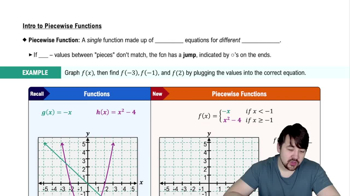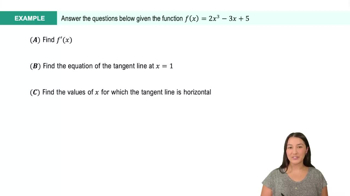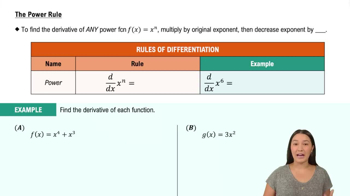Table of contents
- 0. Functions7h 52m
- Introduction to Functions16m
- Piecewise Functions10m
- Properties of Functions9m
- Common Functions1h 8m
- Transformations5m
- Combining Functions27m
- Exponent rules32m
- Exponential Functions28m
- Logarithmic Functions24m
- Properties of Logarithms34m
- Exponential & Logarithmic Equations35m
- Introduction to Trigonometric Functions38m
- Graphs of Trigonometric Functions44m
- Trigonometric Identities47m
- Inverse Trigonometric Functions48m
- 1. Limits and Continuity2h 2m
- 2. Intro to Derivatives1h 33m
- 3. Techniques of Differentiation3h 18m
- 4. Applications of Derivatives2h 38m
- 5. Graphical Applications of Derivatives6h 2m
- 6. Derivatives of Inverse, Exponential, & Logarithmic Functions2h 37m
- 7. Antiderivatives & Indefinite Integrals1h 26m
- 8. Definite Integrals4h 44m
- 9. Graphical Applications of Integrals2h 27m
- 10. Physics Applications of Integrals 2h 22m
3. Techniques of Differentiation
Basic Rules of Differentiation
Problem 3.2.10
Textbook Question
Use the graph of f(x)=|x| to find f′(x).
 Verified step by step guidance
Verified step by step guidance1
Understand that the function f(x) = |x| is the absolute value function, which is defined as f(x) = x for x >= 0 and f(x) = -x for x < 0.
Recognize that the graph of f(x) = |x| is V-shaped, with a vertex at the origin (0,0). The function is linear on both sides of the vertex.
To find the derivative f′(x), consider the piecewise nature of f(x). For x > 0, f(x) = x, so f′(x) = 1. For x < 0, f(x) = -x, so f′(x) = -1.
At x = 0, the function f(x) = |x| is not differentiable because the left-hand derivative and the right-hand derivative do not match. The left-hand derivative is -1, and the right-hand derivative is 1.
Conclude that f′(x) is a piecewise function: f′(x) = 1 for x > 0, f′(x) = -1 for x < 0, and f′(x) is undefined at x = 0.
 Verified video answer for a similar problem:
Verified video answer for a similar problem:This video solution was recommended by our tutors as helpful for the problem above
Video duration:
3mPlay a video:
Was this helpful?
Key Concepts
Here are the essential concepts you must grasp in order to answer the question correctly.
Absolute Value Function
The absolute value function, denoted as f(x) = |x|, outputs the non-negative value of x regardless of its sign. This function has a V-shaped graph that meets the x-axis at the origin (0,0) and is symmetric about the y-axis. Understanding this function is crucial for analyzing its behavior, particularly at the point where x = 0, where the function changes direction.
Recommended video:

Average Value of a Function
Derivative
The derivative of a function, denoted as f'(x), represents the rate of change of the function with respect to x. It is calculated as the limit of the average rate of change as the interval approaches zero. For piecewise functions like f(x) = |x|, the derivative can differ based on the interval, highlighting the importance of understanding where the function is continuous and differentiable.
Recommended video:

Derivatives
Piecewise Functions
Piecewise functions are defined by different expressions based on the input value. For f(x) = |x|, it can be expressed as f(x) = x for x ≥ 0 and f(x) = -x for x < 0. This distinction is essential for finding the derivative, as the slope of the function changes at the point where the definition switches, particularly at x = 0, where the derivative does not exist due to a cusp.
Recommended video:

Piecewise Functions

 3:59m
3:59mWatch next
Master Derivatives of Linear Functions with a bite sized video explanation from Callie
Start learningRelated Videos
Related Practice







